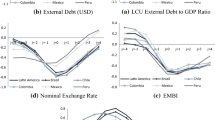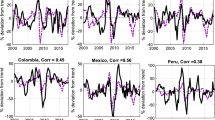Abstract
We assess the transmission of monetary policy and the impact of fluctuations in commodity prices on the real economy for the five biggest and fastest growing emerging market economies: Brazil, Russia, India, China and South Africa (BRICS). Using modern econometric techniques, we show that a monetary policy contraction has a negative effect on output, suggesting that it can lean against unexpected macroeconomic shocks even when the financial markets are not well-developed in this group of countries. We also uncover the importance of commodity price shocks, which lead to a rise in inflation and demand an aggressive behaviour from central banks towards inflation stabilisation.













Similar content being viewed by others
Notes
Taylor (2001) also emphasizes that exchange rate stabilization can help promoting output stabilization and bringing down inflation to a targeted level.
Interestingly, Vasicek (2011a) shows that the degree of inflation persistence is higher for new EU member states than for developed economies.
The variance-covariance matrix of the residuals is decomposed using a triangular Choleski identification.
We use CPI inflation in each country as an indicator of the dynamics of inflation in all countries except India, where WPI-based inflation is used as an indicator of consumer prices.
Interestingly, Milas and Otero (2003) use a non-linear approach to model official and parallel exchange rates in a Latin American emerging market economy (Colombia). For China, Kubo (2009) investigates the role of quantity and price measures to achieve the equilibrium of the balance of payments and the stability of the financial system.
In accordance with Esanov et al. (2005), who highlight the role of monetary aggregates as policy instruments, we also compute the impulse-response functions under this set up. They are both quantitatively and qualitatively similar to the ones displayed in Fig. 2a and are available upon request. For a review of the changes in the conduct of monetary policy in Russia, see Granville and Mallick (2010). For an interesting assessment of the bank lending channel in Russia, see Vinhas de Souza (2006).
References
Aaron J, Muellbauer J (2007) Review of monetary policy in South Africa since 1994. J Afr Econ 16(5):705–744
Ahmed S (2003) Sources of economic fluctuations in Latin America and implications for choice of exchange rate regimes. J Dev Econ 72(1):181–202
Batini N, Levine P, Pearlman J (2007) Monetary rules in emerging economies with financial market imperfections. In: Galí J, Gertler M (eds) International Dimensions of Monetary Policy, NBER Conference Volume, Chapter 5, 251–311: The University of Chicago Press
Blundell R, Bond S (1998) Initial conditions and moment restrictions in dynamic panel data models. J Econ 87(1):115–143
Burdekin RCK, Siklos PL (2008) What has driven Chinese monetary policy since 1990? Investigating the People’s bank’s policy rule. J Int Money Finance 27(5):847–859
Calvo GA, Mishkin FS (2003) The mirage of exchange rate regimes for emerging market economies. J Econ Perspect 17(4):99–118
Castro V, Sousa RM (2012) How do central banks react to wealth composition and asset prices? Econ Model 29(3):641–653
Christiano LJ, Eichenbaum M, Evans CL (2005) Nominal rigidities and the dynamic effects of a shock to monetary policy. J Polit Econ 113(1):1–45
Devereux MB, Lane PR, Xu J (2006) Exchange rates and monetary policy in emerging market economies. Econ J 116(511):478–506
Du Plessis S (2006) Reconsidering the business cycle and stabilisation policies in South Africa. Econ Model 23(5):761–774
Esanov A, Merkl C, Vinhas de Souza L (2005) Monetary policy rules for Russia. J Comp Econ 33(3):484–499
Granville B, Mallick SK (2009) Monetary and financial stability in the euro area: pro-cyclicality versus trade-off. J Int Financ Mark Inst Money 19:662–674
Granville B, Mallick SK (2010) Monetary policy in Russia: identifying exchange rate shocks. Econ Model 27:432–444
Holtz-Eakin D, Newey W, Rosen HS (1988) Estimating vector autoregressions with panel data. Econometrica 56(6):1371–1395
IMF (2011) World Economic outlook. International Monetary Fund, Washington
Kubo A (2009) The effects of a monetary policy shock: evidence from India. Econ Bull 29(3):1530–1541
Mallick SK (2006) Policy instruments to avoid output collapse: an optimal control model for India. Appl Financ Econ 16(10):761–776
Martin C, Milas C (2004) Modelling monetary policy: Inflation targeting in practice. Economica 71(282):209–221
Martin C, Milas C (2010) Financial stability and monetary policy. University of Bath, Department of Economics, Working Paper No. 5
Milas C, Otero JG (2003) Modelling official and parallel exchange rates in Colombia under alternative regimes: a non-linear approach. Econ Model 20(1):165–179
Morón E, Winkelried D (2005) Monetary policy rules for financially vulnerable economies. J Dev Econ 76(1):23–51
Singh K, Kalirajan K (2006) Monetary policy in India: objectives, reaction function and policy effectiveness. Rev Appl Econ 2(2):181–199
Sousa RM (2010) Housing wealth, financial wealth, money demand and policy rule: evidence from the euro area. North Am J Econ Financ 21(1):88–105
Sousa RM (2012) Wealth, asset portfolio, money demand and policy rule. Bull Econ Res, forthcoming
Taylor JB (2001) The role of the exchange rate in monetary policy rules. Am Econ Rev Pap Proc 91:263–267
Taylor JB (2002) Using monetary policy rules in emerging market economies. Stabilisation and Monetary Policy, Banco de Mexico, 441–457
Uhlig H (2005) What are the effects of monetary policy on output? Results from an agnostic identification procedure. J Monet Econ 52(2):381–419
Vasicek B (2010) The monetary policy rules and the inflation process in open emerging economies: evidence for 12 new EU members. East Eur Econ 48(4):37–58
Vasicek B (2011a) Inflation dynamics and the New Keynesian Phillips curve in four Central European countries. Emerg Mark Financ Trade, forthcoming
Vasicek B (2011b) Is monetary policy in new EU member states asymmetric? Czech National Bank, Working Paper No. 5
Vinhas de Souza L (2006) Estimating the bank lending channel in Russia. Bank Credit 9:3–13
Wang S, Handa J (2007) Monetary policy rules under a fixed exchange rate regime: empirical evidence from China. Appl Financ Econ 17(12):941–950
Zhang W (2009) China’s monetary policy: quantity versus price rules. J Macroecon 31(3):473–484
Author information
Authors and Affiliations
Corresponding author
Additional information
We gratefully acknowledge the constructive comments made by the Editor-in-chief, George S. Tavlas, and two anonymous referees of this journal.
Rights and permissions
About this article
Cite this article
Mallick, S.K., Sousa, R.M. Commodity Prices, Inflationary Pressures, and Monetary Policy: Evidence from BRICS Economies. Open Econ Rev 24, 677–694 (2013). https://doi.org/10.1007/s11079-012-9261-5
Published:
Issue Date:
DOI: https://doi.org/10.1007/s11079-012-9261-5




